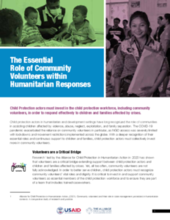This is a 3-page document targeting donors, policy makers, and UN agencies regarding the roles of volunteers and how decision makers can support their roles.
Background:
Child protection actors in humanitarian and development settings have long recognized the role of communities in assisting children affected by violence, abuse, neglect, exploitation, and family separation. The COVID-19 pandemic exacerbated the reliance on community volunteers in particular, as NGO access was severely limited with lockdowns and movement restrictions implemented across the globe. With a deeper recognition of their essential roles and continuous support to children and families, child protection actors must collectively invest more in community volunteers.
Additional Resources:
- Exploratory Study Report | Community Engagement in Case Management: The full research report with the findings and recommendations for child protection actors in humanitarian settings. (Only available in English)
- Study Brief | Community Engagement in Case Management: A 5-page document that summarizes the findings and recommendations for (Available in English, Arabic, Spanish, French)
- Policy Brief | Community Engagement in Case Management: A 3-page document targeting donors, policy makers, and UN agencies regarding the roles of volunteers and how decision makers can support their roles (Available in English, Arabic, Spanish, French)
- 7 Best Practices to Support Community Volunteers: A poster for Child Protection teams to emphasize the evidence based practices of engaging volunteers that were documented in the research (Available in English, Arabic, Spanish, French)
To watch the virtual launch of the Community Engagement in Case Management Study, click here.

